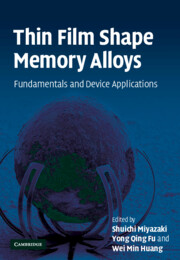Book contents
- Frontmatter
- Contents
- List of contributors
- Preface
- Abstracts of chapters
- 1 Overview of sputter-deposited TiNi based thin films
- 2 Martensitic transformation in TiNi alloys
- 3 Deposition techniques for TiNi thin film
- 4 TiNi multilayer thin films
- 5 Crystallization and microstructural development
- 6 Mechanical properties of TiNi thin films
- 7 Stress and surface morphology evolution
- 8 Ion implantation processing and associated irradiation effects
- 9 Laser post-annealing and theory
- 10 Overview of thin film shape memory alloy applications
- 11 Theory of SMA thin films for microactuators and micropumps
- 12 Binary and ternary alloy film diaphragm microactuators
- 13 TiNi thin film devices
- 14 Shape memory microvalves
- 15 Superelastic thin films and applications for medical devices
- 16 Fabrication and characterization of sputter-deposited TiNi superelastic microtubes
- 17 Thin film shape memory microcage for biological applications
- 18 Shape memory thin film composite microactuators
- 19 TiNi thin film shape memory alloys for optical sensing applications
- Index
15 - Superelastic thin films and applications for medical devices
Published online by Cambridge University Press: 23 February 2010
- Frontmatter
- Contents
- List of contributors
- Preface
- Abstracts of chapters
- 1 Overview of sputter-deposited TiNi based thin films
- 2 Martensitic transformation in TiNi alloys
- 3 Deposition techniques for TiNi thin film
- 4 TiNi multilayer thin films
- 5 Crystallization and microstructural development
- 6 Mechanical properties of TiNi thin films
- 7 Stress and surface morphology evolution
- 8 Ion implantation processing and associated irradiation effects
- 9 Laser post-annealing and theory
- 10 Overview of thin film shape memory alloy applications
- 11 Theory of SMA thin films for microactuators and micropumps
- 12 Binary and ternary alloy film diaphragm microactuators
- 13 TiNi thin film devices
- 14 Shape memory microvalves
- 15 Superelastic thin films and applications for medical devices
- 16 Fabrication and characterization of sputter-deposited TiNi superelastic microtubes
- 17 Thin film shape memory microcage for biological applications
- 18 Shape memory thin film composite microactuators
- 19 TiNi thin film shape memory alloys for optical sensing applications
- Index
Summary
Abstract
Superelastic shape memory materials are of special interest in medical applications due to the large obtainable strains, the constant stress level and their biocompatibility. TiNi sputtered tubes have high potential for application as vascular implants, e.g. stents, whereas superelastic TiNi-polymer-composites could be used for novel applications in orthodontics and medical instrumentation as well as in certain areas of mechanical engineering. In orthodontic applications, lowering the forces which are applied on the teeth during archwire treatment is of special importance due to tooth root resorption, caused by the application of oversized forces. Furthermore, the use of superelastic materials or composites enables the application of constant forces independent of diminutive tooth movements during the therapy due to the superelastic plateau. Superelastic TiNi thin films have been fabricated by magnetron sputtering using extremely pure cast melted targets. Special heat treatments were performed for the adjustment of the superelastic properties and the transformation temperatures. A superelastic strain exceeding 6% at 36 °C was obtained.
Introduction
TiNi based shape memory effects are related to a reversible phase transformation between a high temperature phase (austenite, B2) and a low temperature phase (martensite, B190) showing a different crystal structure. Phase transformation can be achieved by temperature (one-way or two-way effect) and/or stress (superelasticity). In Ni-rich TiNi alloys, an intermediate phase can appear after a heat treatment below 500 °C, this phase is called the R phase (rhombohedral) and the existence of this R phase supports the formation of stress induced martensite. Superelastic shape memory materials are of special interest in medical applications due to the large obtainable strains (up to 8 %), the constant stress level and their biocompatibility.
- Type
- Chapter
- Information
- Thin Film Shape Memory AlloysFundamentals and Device Applications, pp. 370 - 384Publisher: Cambridge University PressPrint publication year: 2009
- 1
- Cited by



